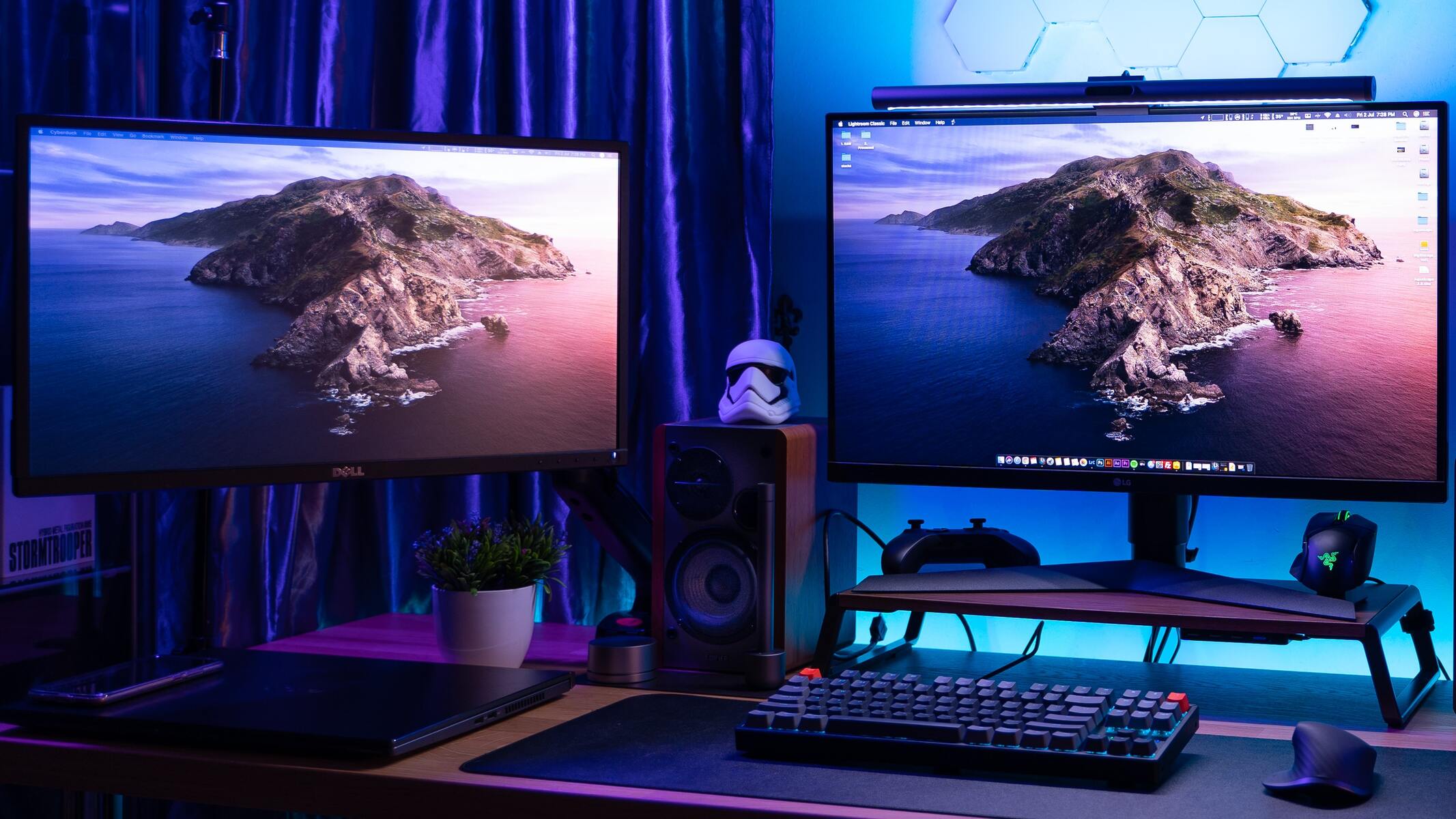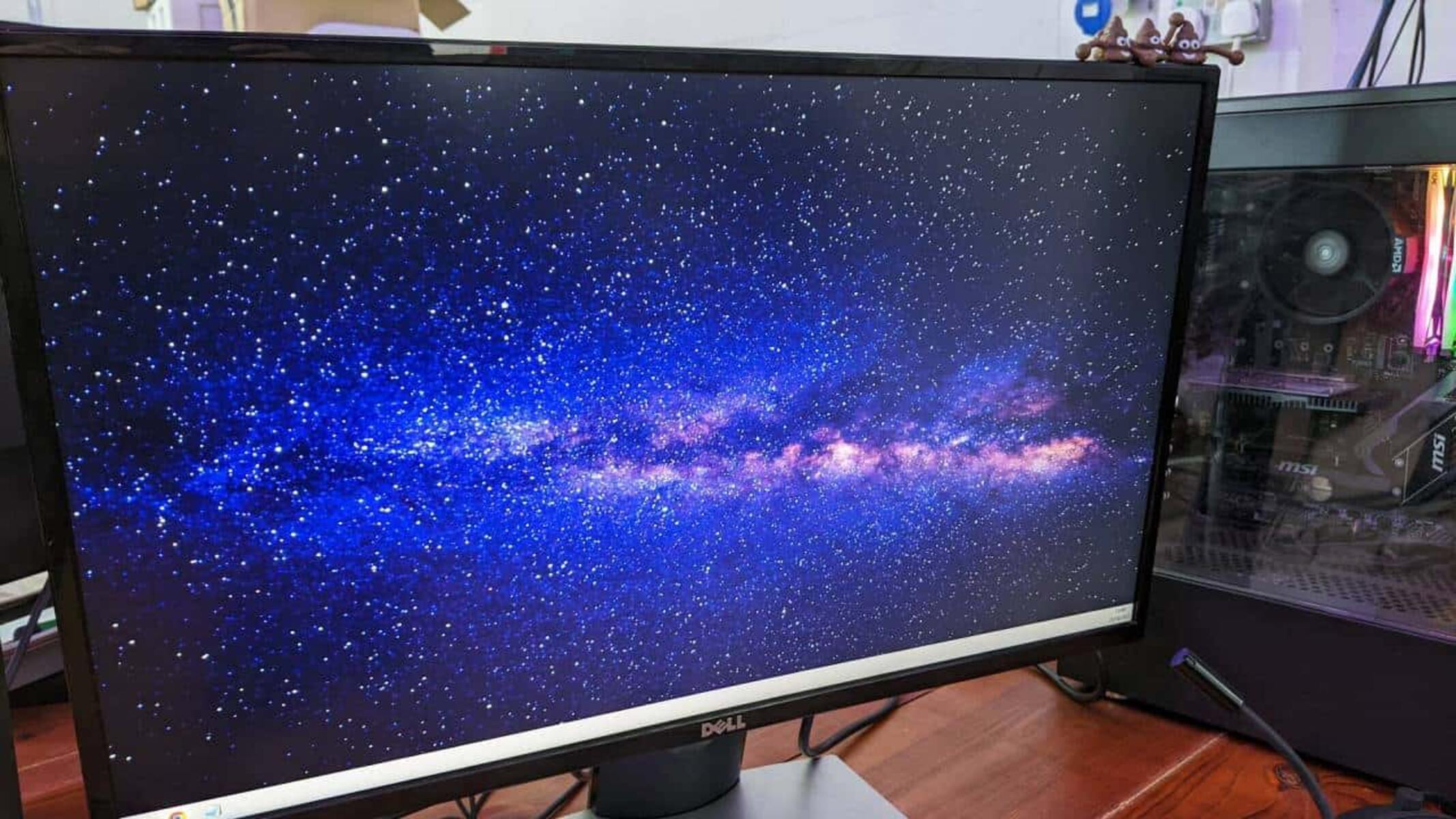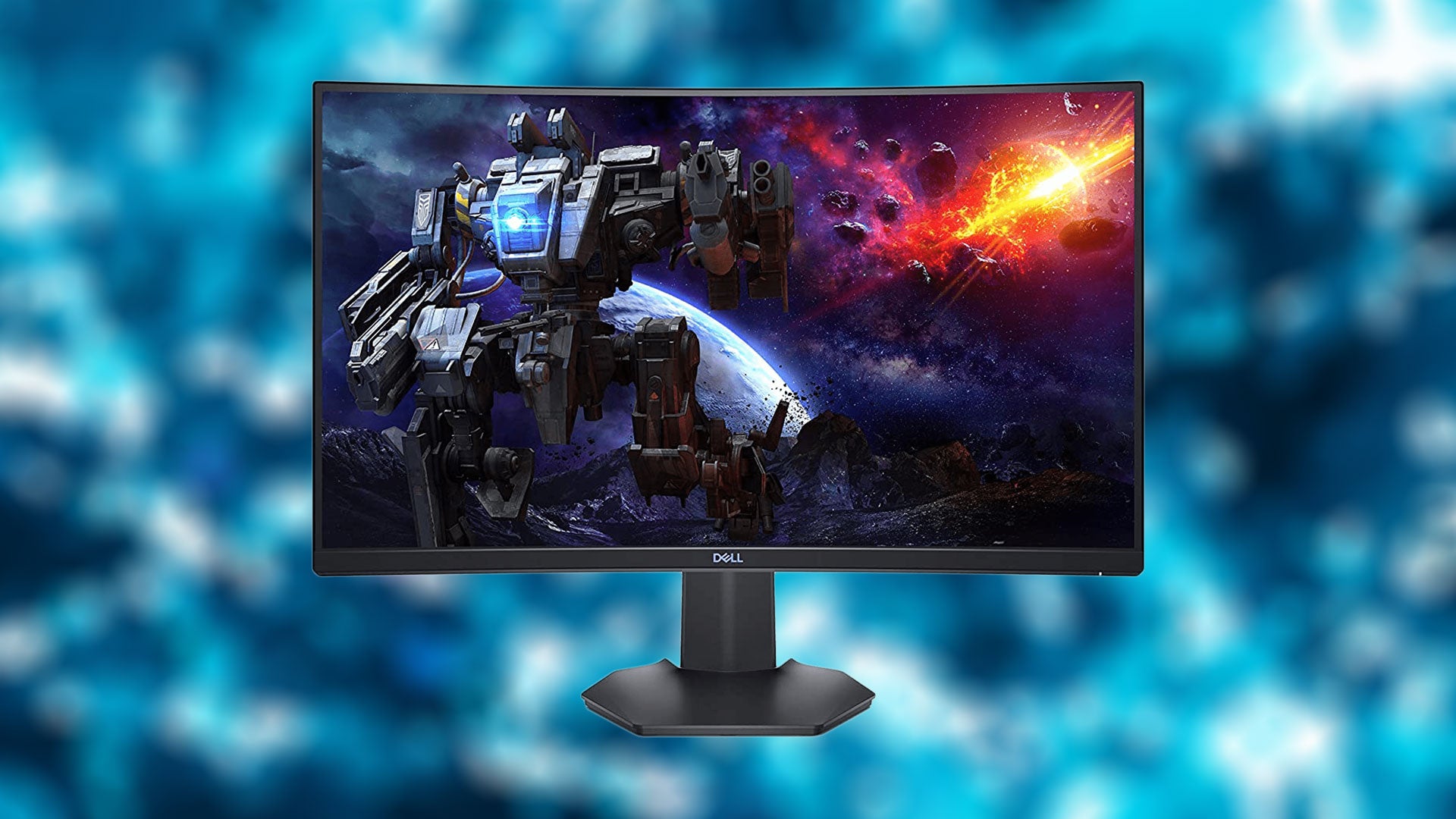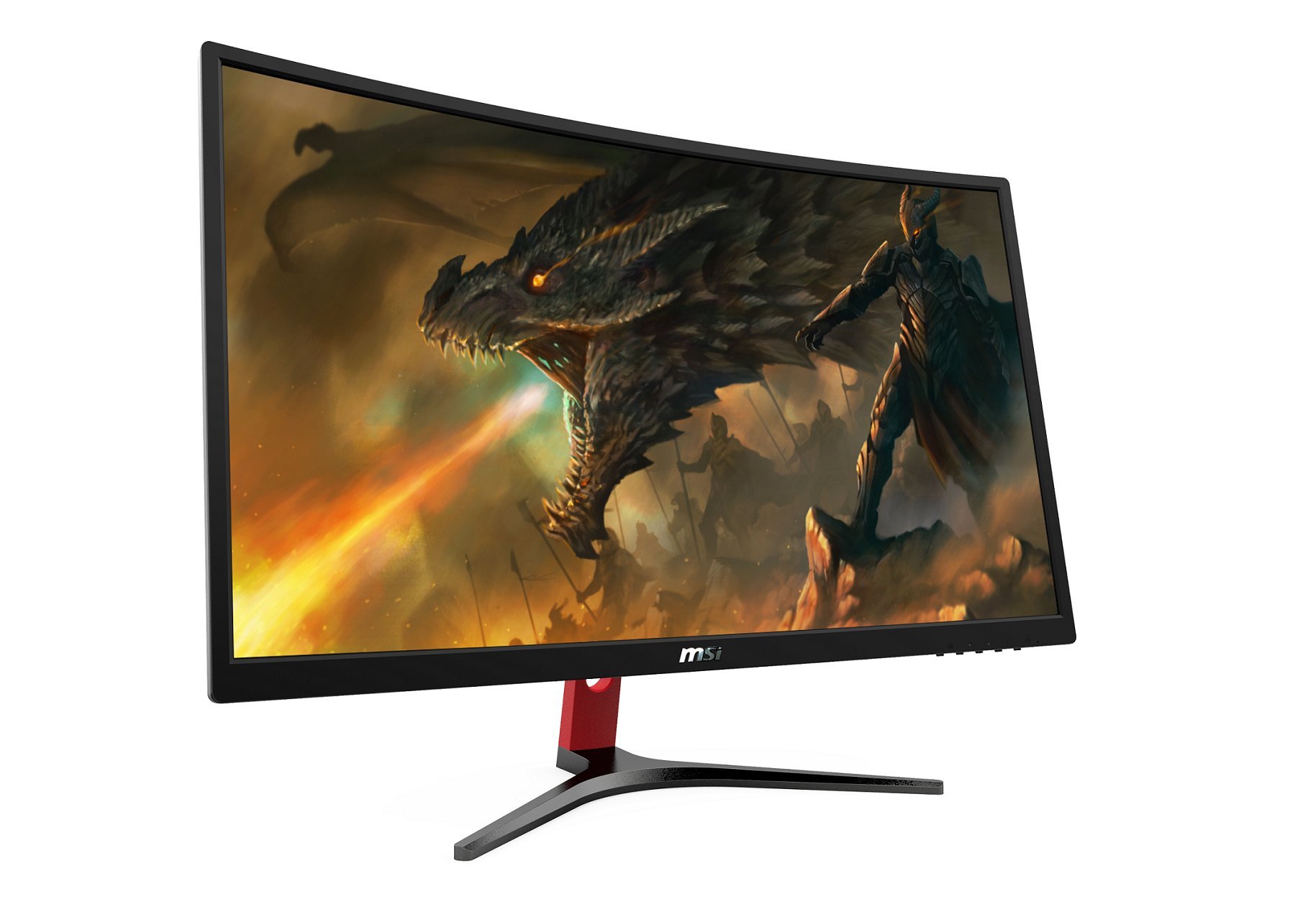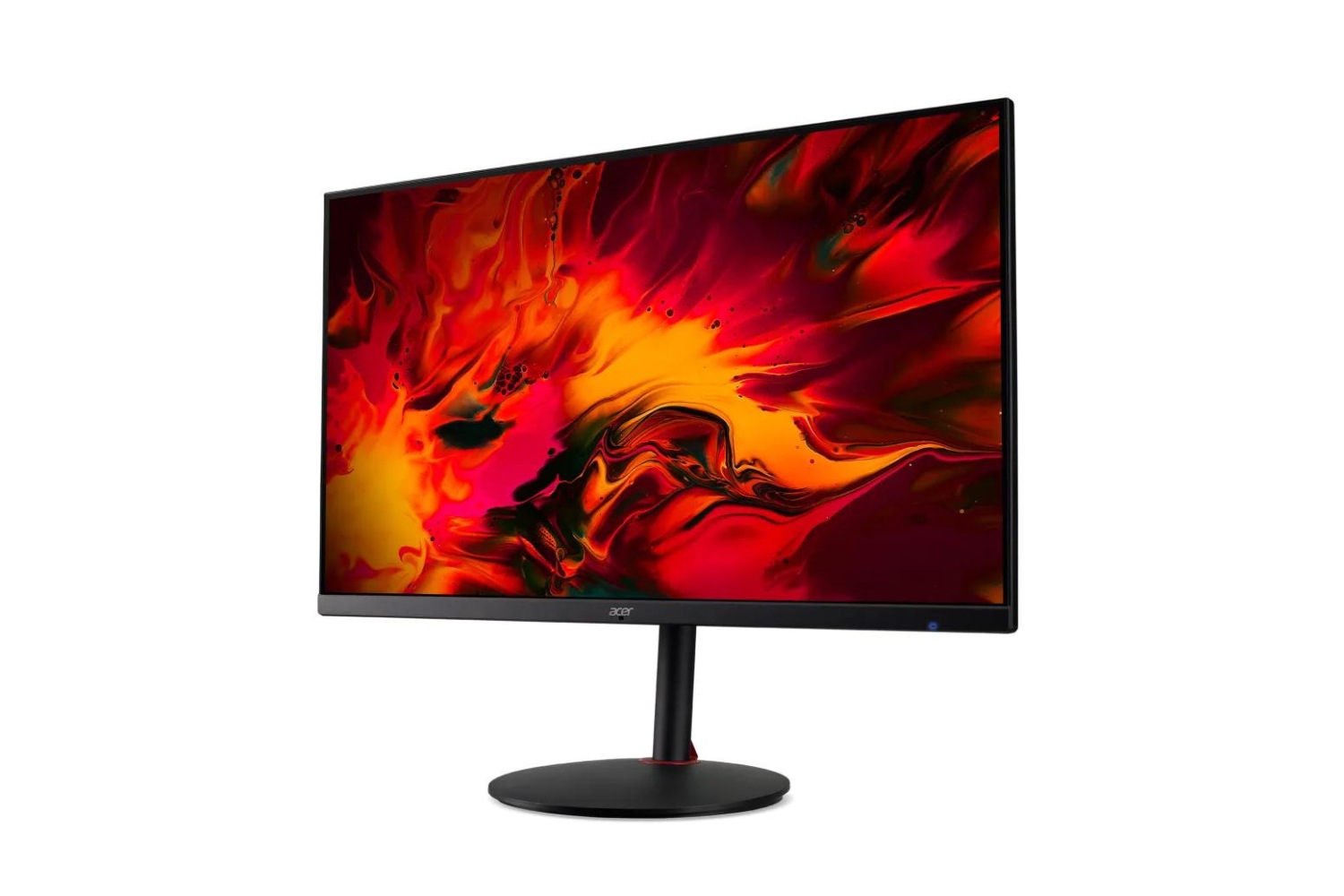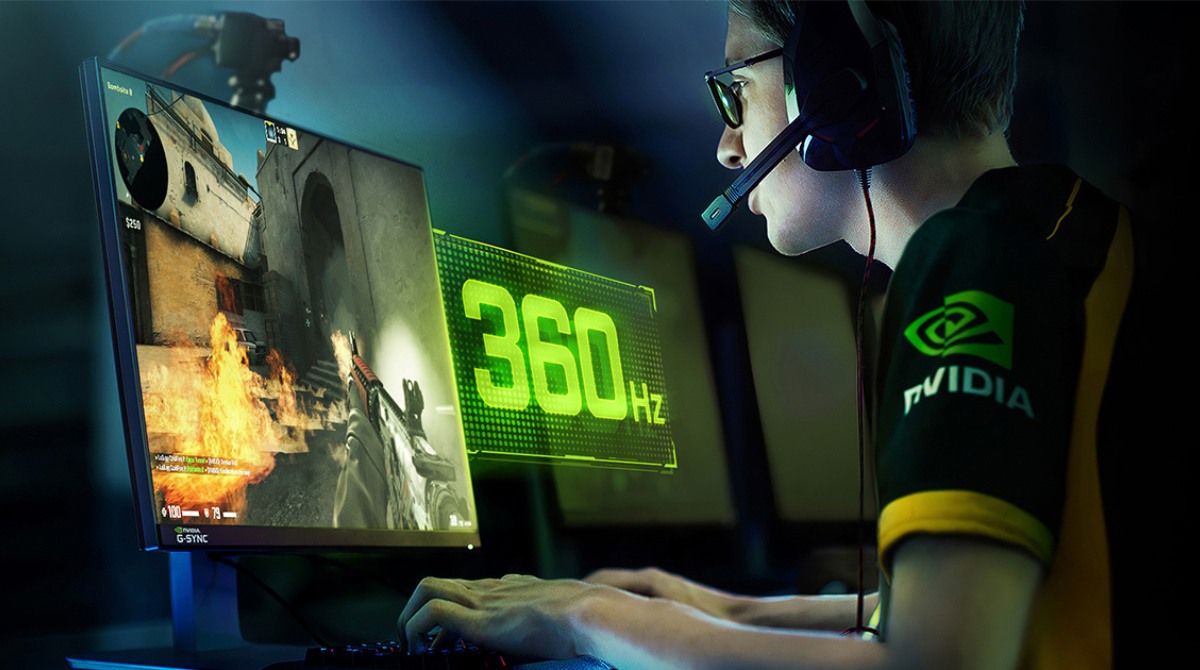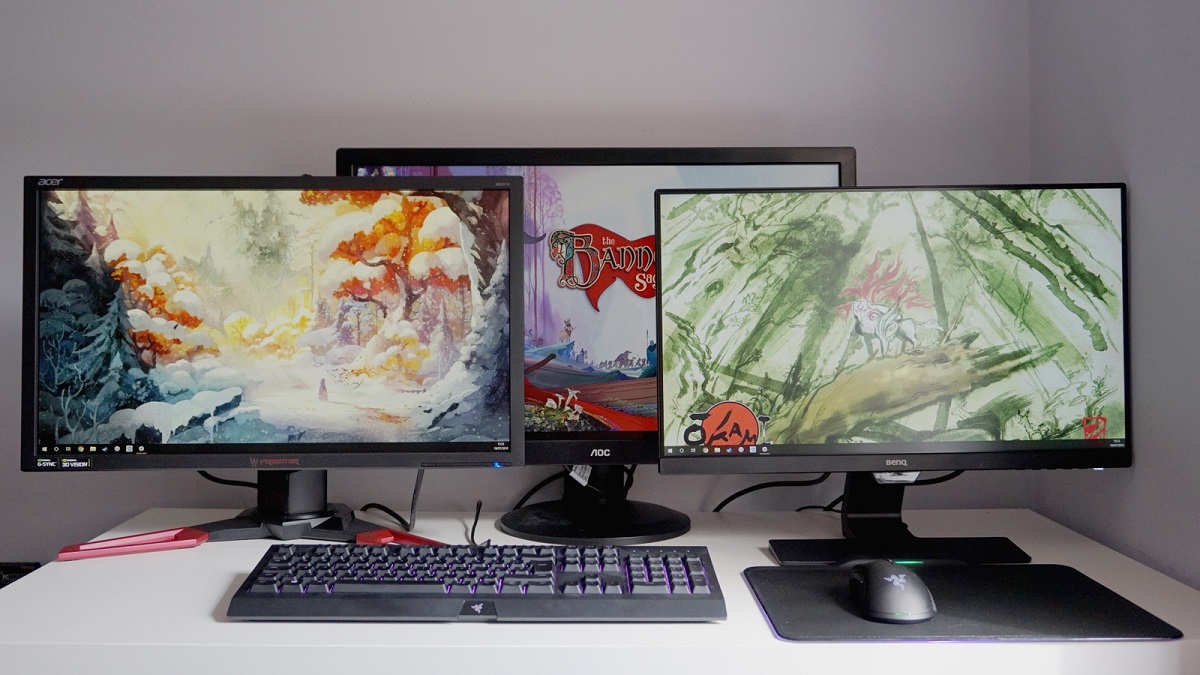Introduction
A gaming monitor is an essential component for any gaming setup. It serves as the primary visual interface between the player and the game, and can greatly impact the overall gaming experience. When choosing a gaming monitor, there are several important factors to consider, such as resolution, refresh rate, response time, and more. Understanding these specifications will help you make an informed decision and find the perfect monitor that suits your gaming needs.
One of the key factors to consider when selecting a gaming monitor is the resolution. The resolution determines the number of pixels that can be displayed on the screen, contributing to the clarity and level of detail in the visuals. Common resolutions for gaming monitors include Full HD (1920×1080 pixels), Quad HD (2560×1440 pixels), and Ultra HD or 4K (3840×2160 pixels). A higher resolution provides a more immersive gaming experience, but also requires more powerful hardware to deliver smooth performance.
Another crucial aspect is the refresh rate, which refers to the number of times the monitor updates the image per second. A higher refresh rate, such as 144Hz or 240Hz, results in smoother and more fluid motion, reducing motion blur and providing a competitive advantage in fast-paced games. However, a higher refresh rate may require a more powerful graphics card to achieve optimal performance.
The response time of a gaming monitor is the time it takes for a pixel to transition from one color to another. A lower response time, typically measured in milliseconds (ms), ensures faster pixel transitions and reduces ghosting or motion artifacts. Ideally, a gaming monitor should have a response time of 1ms or below for optimal gaming performance.
Input lag is another critical factor to consider. It refers to the delay between a user input, such as pressing a button, and the corresponding action appearing on the screen. A lower input lag minimizes the delay, providing a more responsive and immersive gaming experience.
The panel type of a gaming monitor affects various aspects such as color accuracy, contrast ratio, and viewing angles. The three common panel types are Twisted Nematic (TN), In-Plane Switching (IPS), and Vertical Alignment (VA). TN panels are known for their fast response times and high refresh rates, but may sacrifice color accuracy and viewing angles. IPS panels offer better color reproduction and wider viewing angles, but with slightly slower response times. VA panels strike a balance between the two, offering decent response times and good color reproduction.
Resolution
The resolution of a gaming monitor refers to the number of pixels that can be displayed on the screen. It plays a crucial role in determining the level of detail and clarity in the visuals. The higher the resolution, the more detailed and immersive the gaming experience can be. However, it’s important to consider your hardware capabilities and gaming preferences when choosing a resolution.
One of the most common resolutions for gaming monitors is Full HD (1920×1080 pixels). This resolution provides a good balance between visual quality and performance, making it a popular choice among gamers. It offers sharp images and smooth gameplay on most modern gaming systems. Full HD monitors are relatively affordable and can be paired with mid-range graphics cards for an enjoyable gaming experience.
If you’re looking for a more visually stunning experience, Quad HD (2560×1440 pixels) might be the resolution for you. It offers a higher pixel density than Full HD, resulting in sharper details and more vibrant colors. Quad HD monitors provide a noticeable improvement in visual quality, especially in games with detailed environments or graphics. However, they require a more powerful graphics card to handle the higher resolution and maintain smooth gameplay.
For the ultimate in visual fidelity, Ultra HD or 4K (3840×2160 pixels) gaming monitors deliver breathtaking levels of detail. With four times the pixels of Full HD, 4K monitors offer incredibly sharp images and lifelike visuals. They are especially beneficial in large displays where the additional pixels can make a significant difference in image quality. However, running games at 4K requires a high-end graphics card to achieve playable frame rates, and it’s worth noting that not all games are optimized for this resolution.
When considering the resolution, it’s important to take into account your hardware capabilities. Higher resolutions demand more processing power and memory from your graphics card, so ensure that your system meets the minimum requirements before investing in a higher resolution monitor. Additionally, consider the size of the monitor you plan to purchase, as larger displays benefit more from higher resolutions.
In summary, the resolution of a gaming monitor plays a significant role in the level of detail and visual quality you can expect from your gaming experience. Full HD is a reliable and affordable option for most gamers, while Quad HD and 4K offer enhanced visuals for those with more powerful hardware and a desire for stunning graphics. Consider your hardware capabilities and personal preferences when selecting the resolution that best suits your needs.
Refresh Rate
The refresh rate of a gaming monitor refers to how many times the screen updates with new images per second. It is typically measured in Hertz (Hz). The refresh rate plays a crucial role in determining the smoothness and fluidity of motion on the screen during gaming. A higher refresh rate can result in a more immersive and responsive gaming experience.
A standard refresh rate for gaming monitors is 60Hz, meaning the screen refreshes 60 times per second. While 60Hz is sufficient for most casual gaming, it may not provide the smoothest experience in fast-paced games with quick movements. However, with a higher refresh rate, such as 144Hz or 240Hz, the screen updates more frequently and reduces motion blur, resulting in smoother visuals and giving players a competitive edge.
Having a higher refresh rate offers several advantages. First, it allows for smoother and more fluid motion, which can make a noticeable difference when navigating through fast-paced gameplay or engaging in competitive gaming. The increased refresh rate helps to reduce motion blur and increases the responsiveness of the monitor, resulting in more precise control and improved accuracy.
It’s important to note that achieving the full benefits of a higher refresh rate requires a computer capable of producing a high frame rate to match the monitor’s refresh rate. If the hardware cannot keep up with the refresh rate, the benefits may not be fully realized, and the gameplay quality could be affected.
Additionally, the increased refresh rate can be especially beneficial in certain game genres, such as first-person shooters or racing games, where quick reflexes and smooth visuals are crucial. Gamers who are competitive or aspire to be at a professional level may find a higher refresh rate essential for maintaining a competitive edge.
While higher refresh rates offer significant advantages, it’s worth considering the trade-offs. Monitors with higher refresh rates tend to come with a higher price tag. Additionally, running games at higher refresh rates may require a more powerful graphics card and CPU to consistently achieve the desired frame rates. Gamers should weigh the benefits against the cost and ensure their hardware can handle the demands of a higher refresh rate.
In summary, the refresh rate of a gaming monitor is an important specification that can greatly impact the gaming experience. Higher refresh rates provide smoother and more fluid motion and are particularly beneficial for fast-paced and competitive gaming. However, it is essential to consider the hardware capabilities, as well as the added cost, when deciding on the optimal refresh rate for your gaming setup.
Response Time
The response time of a gaming monitor is a critical specification that refers to the time it takes for a pixel to transition from one color to another. It is typically measured in milliseconds (ms). A lower response time indicates faster pixel transitions and can help reduce ghosting and motion blur, resulting in smoother visuals and improved gaming performance.
The response time is especially important in fast-paced games where quick movements and rapid transitions occur frequently. A faster response time ensures that the monitor can keep up with the action, minimizing blurring and artifacts that can hinder gameplay and reduce overall clarity.
Most gaming monitors feature response times ranging from 1ms to 4ms. Monitors with a response time of 1ms are generally considered to offer the best performance in terms of reducing motion blur and ghosting. These monitors are well-suited for competitive gaming or any situation where precise visuals are crucial, such as first-person shooters, racing games, or fighting games.
Monitors with response times between 2ms and 4ms are also suitable for gaming, especially for casual players or those who prioritize other features such as color accuracy or resolution. While these monitors may have slightly more motion blur compared to 1ms options, the difference is often negligible to the average gamer.
It’s important to note that the listed response time may not always directly reflect the actual performance in real-world situations. Various factors, including the specific panel technology, can impact how well a monitor delivers on its advertised response time. Therefore, it’s a good idea to read reviews and user feedback to get a better understanding of a monitor’s real-world performance.
When selecting a gaming monitor, it often comes down to finding the right balance between response time and other features you prioritize. However, it’s generally recommended to opt for a monitor with a low response time to ensure smooth and responsive gameplay. The faster pixel transitions can greatly improve the gaming experience, particularly in fast-action games.
It’s worth noting that while a lower response time can be beneficial, it may not be the only factor influencing the overall gaming experience. Other specifications, such as refresh rate, resolution, and input lag, also play significant roles. Therefore, it’s crucial to consider all of these factors collectively when choosing the ideal gaming monitor for your setup.
In summary, response time is an essential specification to consider when choosing a gaming monitor. A lower response time ensures faster pixel transitions, reducing motion blur and ghosting for a smoother and more responsive gaming experience. While a 1ms response time is often ideal for competitive gaming, monitors with slightly higher response times can still deliver excellent performance for most gamers.
Input Lag
Input lag is a crucial factor to consider when choosing a gaming monitor, as it directly impacts the responsiveness and accuracy of your gaming experience. Input lag refers to the delay between a user input, such as pressing a button or moving the mouse, and the corresponding action appearing on the screen. A lower input lag ensures a more immediate and accurate representation of your inputs, resulting in a more immersive and enjoyable gaming experience.
For competitive gamers and those who value precise timing and responsiveness, minimizing input lag is essential. Even a fraction of a second delay can make a noticeable difference, especially in fast-paced games where split-second reactions can determine success or failure. In these situations, having a monitor with low input lag can provide a competitive advantage.
Input lag can be influenced by various factors, including the monitor’s internal processing, signal transmission, and display technology. Monitors with built-in image processing features or excessive video post-processing may introduce additional input lag. Therefore, it’s important to consider gaming monitors that prioritize low input lag to maintain optimal responsiveness.
When comparing input lag specifications, it’s important to keep in mind that advertised values may not always reflect real-world performance. Factors such as the source device’s output lag and the game’s own input processing time can also contribute to the overall input delay. Therefore, it’s recommended to refer to reviews and user feedback to gain a more accurate understanding of a specific monitor’s input lag performance.
It’s worth noting that input lag can vary across different gaming monitors, even within the same brand or model range. Therefore, it’s always beneficial to test a monitor before making a purchase, if possible. Many retailers and tech expos offer opportunities to try out displays, allowing you to experience firsthand how a monitor responds to your inputs.
Furthermore, it’s important to ensure that the other hardware components in your gaming setup, such as the graphics card and input devices, are capable of reducing additional input lag throughout the system. It’s recommended to use a gaming mouse and keyboard with low response times and a high polling rate to minimize any potential signal delay.
In summary, input lag is a crucial factor to consider when selecting a gaming monitor. Minimizing input lag ensures a more immediate and accurate response to user inputs, enhancing the gaming experience, and providing a competitive edge. While advertised specifications can provide a general idea of a monitor’s input lag, it’s essential to rely on real-world tests and user feedback to assess the actual performance of a specific model.
Panel Type
The panel type of a gaming monitor refers to the technology used to create the display. It plays a significant role in determining various aspects of the monitor’s performance, including color accuracy, contrast ratio, viewing angles, and response times. Understanding the different panel types can help you choose a gaming monitor that best suits your needs and preferences.
The three main panel types commonly used in gaming monitors are Twisted Nematic (TN), In-Plane Switching (IPS), and Vertical Alignment (VA).
Twisted Nematic (TN) panels are known for their fast response times and high refresh rates. They are often preferred by competitive gamers who prioritize swift and responsive gameplay. TN panels can achieve response times as low as 1ms, making them ideal for fast-paced games where every millisecond matters. However, TN panels tend to have poorer color accuracy and narrower viewing angles compared to other panel types. Colors may appear washed out, and the image quality may degrade when viewed from off-center angles.
In-Plane Switching (IPS) panels offer better color reproduction and wider viewing angles compared to TN panels. IPS panels provide more accurate and vibrant colors, making them suitable for gamers who value visual quality and color accuracy. However, IPS panels generally have slightly slower response times compared to TN panels. While gaming-specific IPS panels have improved response times, they may not match the ultra-fast response times of TN panels. The difference in response times is often negligible for casual gamers or those who prioritize visual fidelity over instantaneous response.
Vertical Alignment (VA) panels strike a balance between TN and IPS panels, offering decent response times and good color reproduction. VA panels usually have better contrast ratios compared to TN and IPS panels, resulting in deeper blacks and better overall image quality. VA panels also offer wider viewing angles compared to TN panels, making them suitable for multiplayer gaming where multiple players may be viewing the screen from different angles. However, VA panels may exhibit slightly slower response times compared to TN panels, although gaming-oriented VA panels have improved response times to mitigate this issue.
When choosing a gaming monitor, the panel type you select should align with your priorities and preferences. If you prioritize fast and responsive gameplay, a TN panel may be the best choice. If color accuracy and wide viewing angles are important to you, an IPS panel would be a better fit. If you want a balance between response times and image quality, a VA panel may be suitable for your needs.
It’s worth noting that there can be variations in the performance and quality of panels, even within the same panel type. It’s recommended to read reviews and user feedback to get a better understanding of the specific monitor model’s performance and characteristics.
In summary, the panel type of a gaming monitor determines various aspects of its performance, including color accuracy, contrast ratio, viewing angles, and response times. TN panels provide faster response times, although sacrificing color accuracy and viewing angles. IPS panels offer better color reproduction and wider viewing angles, but with slightly slower response times. VA panels strike a balance between the two, offering decent response times and good image quality. Consider your priorities and preferences when choosing the panel type that best suits your gaming needs.
Adaptive Sync
Adaptive Sync is a technology designed to eliminate screen tearing and provide a smoother gaming experience by synchronizing the refresh rate of the monitor with the frame rate of the graphics card. It aims to mitigate the visual artifacts that occur when the monitor’s refresh rate and the graphics card’s frame rate are out of sync. Adaptive Sync technology comes in two main forms: AMD FreeSync and NVIDIA G-Sync.
AMD FreeSync is an open-source technology that is compatible with AMD graphics cards. FreeSync allows the monitor to dynamically adjust its refresh rate within a specific range to match the frame rate outputted by the graphics card. This results in a smoother gaming experience with reduced screen tearing and stuttering. FreeSync monitors are generally more affordable, as the technology does not require a proprietary module.
NVIDIA G-Sync, on the other hand, is a proprietary technology specifically designed for NVIDIA graphics cards. G-Sync monitors incorporate a dedicated hardware module that communicates with the graphics card, determining the optimal refresh rate for each frame. This precise synchronization minimizes screen tearing and provides a smoother gaming experience. G-Sync monitors tend to have a higher price point due to the additional cost of the hardware module.
Both FreeSync and G-Sync technologies aim to deliver a tear-free gaming experience, but they differ in terms of compatibility. FreeSync is compatible with a wide range of AMD graphics cards and even some recent NVIDIA graphics cards that support Adaptive Sync. G-Sync, on the other hand, requires an NVIDIA graphics card to take advantage of the technology. However, NVIDIA has recently introduced G-Sync Compatible, allowing certain FreeSync monitors to work with NVIDIA graphics cards without the need for a dedicated hardware module.
When choosing a gaming monitor, the inclusion of Adaptive Sync technology can greatly enhance the gaming experience. With Adaptive Sync enabled, the monitor’s refresh rate and the graphics card’s frame rate are in perfect sync, resulting in smoother gameplay with reduced visual artifacts.
It’s important to note that Adaptive Sync technology requires a compatible graphics card and monitor to work together effectively. Both FreeSync and G-Sync monitors have a specific refresh rate range where the technology operates optimally, so it’s essential to ensure that the monitor’s refresh rate range aligns with the desired frame rates of your games.
In summary, Adaptive Sync technology, whether in the form of AMD FreeSync or NVIDIA G-Sync, greatly enhances the gaming experience by synchronizing the monitor’s refresh rate with the graphics card’s frame rate. This eliminates screen tearing and provides a smoother gameplay experience. Consider the compatibility requirements and the specific features offered by each technology when choosing a gaming monitor to ensure optimal performance with your graphics card.
HDR
HDR, or High Dynamic Range, is a feature found in some gaming monitors that enhances the visual experience by providing a broader range of colors, improved contrast, and greater luminosity. HDR technology aims to deliver more realistic and lifelike visuals, elevating the gaming experience to a new level.
One of the main benefits of HDR is its ability to display a wider color gamut. This means that HDR monitors can reproduce a more extensive range of colors, allowing for more vibrant and accurate representations of various shades and hues. The increased color depth contributes to a more immersive and visually stunning gaming experience.
In addition to color, HDR also improves contrast by increasing the dynamic range between the darkest and brightest parts of an image. This leads to more pronounced details in both shadows and highlights, resulting in a more realistic and visually striking representation of the game world. The enhanced contrast enhances depth perception, making the visuals appear more three-dimensional and lifelike.
Besides color and contrast, HDR also involves increased peak luminosity. HDR monitors are capable of emitting brighter and more intense light, which adds to the visual impact and overall immersion. Bright scenes appear dazzling, while dark scenes have greater depth and detail, leading to a more engaging gaming experience.
However, it’s important to note that not all HDR monitors are created equal. There are different levels of HDR certification, such as HDR10, HDR400, HDR600, and HDR1000, indicating varying capabilities and performance standards. Monitors with higher HDR certification levels typically offer a more impressive HDR experience, with improved color accuracy, contrast, and brightness.
It’s worth mentioning that for a true HDR experience, the content being displayed also needs to be HDR-compatible. This means that the game itself or the media you’re consuming should have been specifically developed or encoded to take advantage of HDR technology. Otherwise, the benefits of HDR may not be fully realized.
When deciding on a gaming monitor, HDR is a feature to consider if you value realistic visuals and a more immersive gaming experience. However, if HDR content availability is limited or the monitor’s HDR capabilities fall short, the impact may not be as pronounced.
In summary, HDR technology enhances the visual experience of gaming monitors by providing a wider color gamut, improved contrast, and increased luminosity. It creates more realistic and visually striking visuals, contributing to a more immersive gaming experience. When considering an HDR monitor, it’s important to understand the various levels of HDR certification and ensure that the monitor’s capabilities align with your expectations and the availability of HDR content.
Viewing Angles
The viewing angles of a gaming monitor refer to the angles from which the screen can be viewed without experiencing significant color shifts or loss of image quality. It is an important aspect to consider, especially if you frequently play games with others or require a wide field of view when gaming.
Twisted Nematic (TN) panels, known for their fast response times, usually have narrower viewing angles compared to other panel types. When viewing a TN panel off-center, the colors may appear washed out or distorted, making it challenging for others to see the screen accurately. TN panels are best suited for situations where a single person typically views the monitor directly.
In-Plane Switching (IPS) panels, on the other hand, offer wider viewing angles. IPS panels provide consistent color accuracy and image quality, even when viewed from extreme angles. This makes them ideal for gamers who often play multiplayer games or those who prefer a larger field of view. IPS panels allow several people to view the screen simultaneously, with minimal loss of image quality.
Vertical Alignment (VA) panels typically offer viewing angles that fall between the narrower TN panels and the wider IPS panels. While VA panels may not provide the same wide viewing angles as IPS panels, they still offer reasonable off-center viewing without significant color shifts or image degradation. VA panels strike a balance between response times, color reproduction, and viewing angles, making them a versatile choice for gamers who want a good compromise.
It’s important to note that the quality of viewing angles can vary among different monitors, even within the same panel type. Factors such as the quality of the panel construction and the monitor’s overall design can affect viewing angles. It’s recommended to read reviews and user feedback to get a better understanding of a monitor’s actual viewing angle performance.
Another consideration is the physical size of the monitor. Larger displays tend to have narrower optimal viewing angles due to the increased distance between the viewer and the edges of the screen. Therefore, it’s important to consider the monitor’s physical size along with its panel type when assessing the viewing angle performance.
In summary, the viewing angles of a gaming monitor determine how well the monitor’s display maintains color accuracy and image quality when viewed from different angles. TN panels have narrower viewing angles, while IPS panels offer wider and more consistent viewing angles. VA panels fall in between, providing reasonable off-center viewing. Consider your gaming setup and the number of people who will be viewing the screen when selecting a monitor to ensure suitable viewing angles.
Brightness and Contrast Ratio
The brightness and contrast ratio are important factors to consider when selecting a gaming monitor, as they greatly impact the visual quality and overall gaming experience. Both of these characteristics contribute to the level of detail, depth, and immersion in the displayed images.
Brightness refers to the luminosity or the amount of light emitted by the monitor. It is measured in nits (cd/m²), with a higher number indicating a brighter display. The appropriate brightness level depends on personal preference, ambient lighting conditions, and the content being displayed. A higher brightness level can enhance visibility in well-lit environments, but it may lead to eye strain in dark or dimly lit rooms.
The contrast ratio is the difference between the darkest and brightest points a monitor can display. It indicates the range of shades and the level of detail that can be achieved in the images. A higher contrast ratio results in more vibrant colors, deeper blacks, and better overall image quality. It enhances the depth and realism of images, making them appear more vivid and lifelike.
It’s worth noting that manufacturers may provide different specifications and methods of measuring contrast ratio, making it important to exercise caution when comparing this aspect across different monitors. The contrast ratio can vary depending on the monitor’s panel type, backlighting technology, and calibration. Reviews and user feedback can provide a more accurate understanding of the actual contrast performance of a specific monitor.
When selecting a gaming monitor, it’s essential to consider your own preferences and the gaming content you will be experiencing. For competitive gaming, a higher brightness level is desirable, as it can improve visibility in fast-paced, brightly lit environments. On the other hand, if you primarily play atmospheric or story-driven games, a monitor with a higher contrast ratio may be more suitable, as it can enhance the richness, detail, and depth of the visuals.
Remember that it’s important to strike a balance between brightness and contrast ratio, as an excessively bright display can lead to eye fatigue, while a poor contrast ratio may result in a flat and dull-looking image. Additionally, environmental factors such as ambient lighting conditions should also be considered. In brightly lit rooms, a monitor with higher brightness and contrast ratio can help combat glare and maintain image clarity.
In summary, the brightness and contrast ratio of a gaming monitor play critical roles in determining the visual quality and immersion of the gaming experience. Brightness affects visibility in different lighting conditions, while contrast ratio enhances color vibrancy and image depth. Finding the right balance between brightness and contrast ratio depends on personal preferences, gaming content, and ambient lighting conditions.
Color Accuracy and Gamut
Color accuracy and gamut are essential considerations when choosing a gaming monitor, as they directly impact the realism, vibrancy, and overall visual quality of the games you play. Color accuracy refers to how faithfully a monitor can reproduce colors, while gamut refers to the range of colors a monitor is capable of displaying.
Color accuracy is crucial for an immersive gaming experience. A monitor with accurate color reproduction ensures that the colors displayed on the screen closely match the intended colors of the game developers. This results in more realistic and lifelike visuals, where the colors of the game world appear rich and vibrant.
One common metric used to measure color accuracy is Delta E (ΔE), which quantifies the difference between a reference color and the color produced by the monitor. The lower the Delta E value, the more accurate the color reproduction. Ideally, a gaming monitor should have a low Delta E value, minimizing any perceptible color inaccuracies.
Gamut refers to the range of colors a monitor can display within the color space it supports. The most common color spaces used in gaming monitors are sRGB and Adobe RGB. sRGB is the standard color space used for web content and gaming, while Adobe RGB offers a wider range of colors, suitable for professional photo and video editing.
When considering gamut, it’s important to ensure that the monitor covers a significant portion of the desired color space. This allows for more vibrant and accurate color reproduction. Some gaming monitors also come with wider color gamut options, such as DCI-P3, which is commonly used in the film industry. These wider gamut options provide a larger range of colors, resulting in more vibrant and dynamic visuals.
Color accuracy and gamut can vary between different gaming monitors, even within the same panel type. Higher-end monitors often feature advanced technologies, such as factory calibration or specific color profiles, to deliver more accurate and consistent color reproduction. It’s advisable to look for monitors that have undergone color calibration by the manufacturer or offer customizable color settings to achieve optimal color accuracy.
For gamers who value color accuracy, it’s recommended to look for gaming monitors with an IPS panel, as this panel type generally offers superior color reproduction compared to TN or VA panels. However, it’s worth noting that the responsiveness and refresh rate of IPS panels may be slightly lower compared to TN panels.
In summary, color accuracy and gamut are crucial factors to consider when selecting a gaming monitor. Accurate color reproduction ensures a more realistic and vibrant gaming experience, while a wider color gamut allows for a more extensive range of colors to be displayed. Look for monitors with low Delta E values, advanced color calibration, and wide gamut options, depending on your preferences and requirements for color accuracy.
Connectivity Options
The connectivity options available on a gaming monitor are crucial for seamlessly integrating your gaming setup and ensuring compatibility with various devices. These options determine how you can connect your monitor to your gaming console, PC, or other devices, allowing you to enjoy an optimal gaming experience.
One of the most common connectivity options is HDMI (High-Definition Multimedia Interface). HDMI ports are found on most gaming monitors and are used to connect gaming consoles, PCs, and other multimedia devices. HDMI supports both video and audio signals, making it a versatile choice for most gaming setups.
DisplayPort is another popular connectivity option for gaming monitors. DisplayPort offers high bandwidth and is known for its capability to deliver high-resolution and high-refresh-rate content. It also supports various audio and video formats, making it suitable for gaming enthusiasts who require the highest performance.
DVI (Digital Visual Interface) is an older connectivity option that is still found on some gaming monitors. It supports video signals but not audio, making it suitable for connecting to PCs or older gaming devices that rely on DVI connectivity.
Some gaming monitors also offer USB ports that can be used for connecting peripherals or charging devices. USB ports are convenient for connecting gaming keyboards, mice, and other accessories, eliminating the need for separate USB hubs or cables.
Additionally, it is worth considering if the gaming monitor supports audio output options. Some monitors have built-in speakers for convenience, but they may not offer the same audio quality as external sound systems. In such cases, having an audio output, such as a headphone jack or audio line-out, allows you to connect external speakers or headphones for a better audio experience.
When considering connectivity options, it’s important to assess your specific gaming setup and the devices you plan to connect to the monitor. Ensure that the monitor has the necessary ports to accommodate your devices without the need for additional adapters or converters, which may introduce compatibility issues or compromise performance.
It’s also important to consider the version numbers associated with the ports. Newer versions, such as HDMI 2.1 or DisplayPort 1.4, offer higher bandwidth and support advanced features like higher resolutions, higher refresh rates, and variable refresh rate technologies like FreeSync or G-Sync.
In summary, connectivity options play a critical role in the compatibility and performance of your gaming monitor. HDMI and DisplayPort are common and versatile options, offering both video and audio support. DVI is still useful for older devices, and USB ports provide convenience for connecting peripherals. Consider the specific connectivity needs of your gaming setup and look for monitors that offer the necessary ports and compatibility with your devices.
Aesthetics and Design
Aesthetics and design are important factors to consider when choosing a gaming monitor, as they contribute to the overall look, feel, and integration of the monitor into your gaming setup. While aesthetics may not directly impact performance, they can greatly enhance the visual appeal and enjoyment of your gaming experience.
One aspect to consider is the physical design of the monitor. Gaming monitors come in various sizes, from compact options to large, widescreen displays. The size should be appropriate for your gaming space and provide an immersive viewing experience without compromising comfort or desk space.
The bezel design of the monitor is another consideration. A thin bezel or edge-less design can create a more seamless and immersive visual experience, as it minimizes distractions and allows for a wider field of view. Aesthetically, a sleek and minimalistic bezel can lend a modern and premium look to the monitor, blending well with contemporary gaming setups.
The stand design of the monitor also plays a role in aesthetics and functionality. Look for a stand that is adjustable and sturdy, allowing you to position the monitor at a comfortable height and angle. Some stands offer cable management features to keep your gaming area tidy and organized.
Another aspect of aesthetics is the backlighting or RGB lighting on the monitor. Many gaming monitors come with customizable lighting options that allow you to personalize the look and feel of your setup. RGB lighting can enhance the ambiance and create a captivating gaming environment. However, it’s important to ensure that the lighting design does not distract you from the gameplay or cause eye strain.
Consider the overall color scheme and design of the monitor, as it should complement your gaming setup and personal tastes. Monitors with color options, such as black, silver, or even bold accent colors, can match your preferred theme or style. Ultimately, the aesthetically pleasing design of the monitor should blend harmoniously with your gaming setup and create a visually appealing environment.
It’s worth noting that while aesthetics are important, they should not be the sole determining factor when selecting a gaming monitor. Prioritize the performance and technical specifications that align with your gaming needs, and then consider the aesthetics to enhance the overall visual aesthetic of your gaming space.
In summary, the aesthetics and design of a gaming monitor serve to enhance the visual appeal and integration of the monitor into your gaming setup. Consider factors such as the physical design, bezel thickness, stand functionality, backlighting options, and overall color scheme. While aesthetics should not be the primary consideration, they can greatly elevate your gaming experience and create a visually captivating gaming environment.
Price Range
Price range is an important factor to consider when choosing a gaming monitor, as it determines the level of features, specifications, and overall quality you can expect within your budget. Gaming monitors come in a wide range of price points, from budget-friendly options to high-end models.
In the lower price range, you can find budget-friendly gaming monitors that offer decent performance for casual gaming. These monitors typically have lower resolution, such as Full HD (1920×1080 pixels), and may have a smaller screen size. While they may not have all the latest features or the highest refresh rates, they can still provide an enjoyable gaming experience at an affordable price. Budget monitors are suitable for casual gamers or those with limited budgets.
In the mid-range price segment, you can find more feature-rich gaming monitors with improved specifications. These monitors often offer higher resolutions, such as Quad HD (2560×1440 pixels) or even Ultra HD or 4K (3840×2160 pixels), along with higher refresh rates, faster response times, and improved color accuracy. They may also include additional features like adaptive sync technologies (FreeSync or G-Sync) and wider viewing angles. Mid-range monitors strike a balance between performance and affordability, catering to gamers who want a good balance of features without breaking the bank.
In the higher price range, you’ll find premium gaming monitors that offer the latest and greatest technologies and specifications. These monitors are geared towards serious gamers, content creators, or professionals who demand the best performance. They often boast high refresh rates (such as 144Hz or 240Hz), fast response times (1ms or lower), wide color gamuts, HDR support, and advanced panel technologies (such as IPS or Quantum Dot). Premium gaming monitors may also come with additional features like ergonomic stands, multiple connectivity options, and customizable RGB lighting. These monitors deliver the utmost in gaming performance and visual quality, but they come with a higher price tag.
When considering the price range, it’s important to assess your budget and prioritize the features and performance that align with your gaming needs. Determine the essential specifications you require, such as resolution, refresh rate, and response time, and then consider optional features based on your budget.
Remember that while a higher price generally correlates with better performance and features, it’s important to strike a balance between your budget and your requirements. Consider reading reviews and user feedback to get an understanding of the quality and performance of specific models within your chosen price range.
In summary, price range is a key consideration when selecting a gaming monitor. Budget-friendly options offer decent performance for casual gaming, mid-range monitors strike a balance between features and affordability, while premium models cater to serious gamers and professionals who demand the highest performance. Assess your budget and prioritize the essential specifications to find the gaming monitor that best fits your needs and wallet.
Conclusion
Choosing the right gaming monitor is essential for an immersive and enjoyable gaming experience. By considering the various factors discussed in this guide, you can make an informed decision that aligns with your gaming preferences and requirements.
Resolution plays a significant role in the level of detail and immersion you can expect from your games. Higher resolutions like Quad HD or 4K offer sharper and more detailed visuals, but they require more powerful hardware to achieve optimal performance. Refresh rate determines the smoothness of motion on the screen, with higher refresh rates providing more fluid gameplay. Response time affects the responsiveness and clarity of fast-moving objects, so a lower response time is preferred for quicker pixel transitions.
Consider the viewing angles and panel type of a gaming monitor, as this determines color accuracy, contrast ratios, and the overall image quality. IPS panels offer wider viewing angles and better color reproduction, while TN panels excel in fast response times. VA panels strike a balance between the two.
Adaptive Sync technology, such as AMD FreeSync or NVIDIA G-Sync, can eliminate screen tearing and provide a smoother gaming experience. HDR enhances visuals with a wider range of colors and improved contrast, creating a more vivid and realistic gaming environment. Connectivity options determine how the monitor integrates with your gaming devices, while aesthetics and design contribute to the overall look and feel of your gaming setup.
Price range should be considered based on your budget and requirements. Budget monitors offer decent performance at an affordable price, mid-range monitors provide a balance of features and affordability, and premium models deliver top-of-the-line performance for serious gamers or professionals.
By carefully considering these factors and finding the right balance between performance, features, and budget, you can select the perfect gaming monitor that enhances your gaming experience and brings your games to life.







